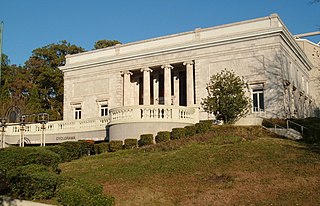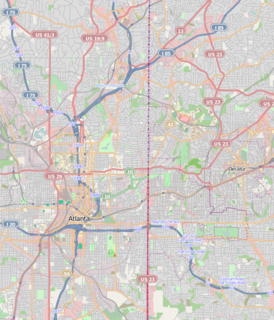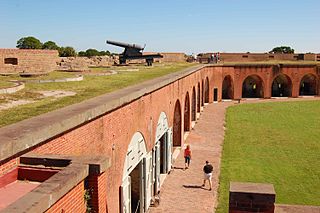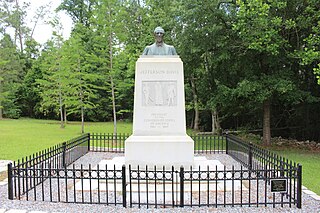 W
WA. H. Stephens State Park, also known as A. H. Stevens Historic Park, is a 1,177 acres (476 ha) Georgia state park located in Crawfordville. The park is named for Alexander Hamilton Stephens, the Vice President of the Confederate States of America, and a former Georgia governor. The park contains Stephens' home, Liberty Hall, which has been fully restored to its original 1875 style. The park's museum houses one of Georgia's largest collections of Civil War artifacts. The park also offers several mill ponds for fishing and nature trails.
 W
WThe Andersonville National Historic Site, located near Andersonville, Georgia, preserves the former Andersonville Prison, a Confederate prisoner-of-war camp during the final fourteen months of the American Civil War. Most of the site lies in southwestern Macon County, adjacent to the east side of the town of Andersonville. As well as the former prison, the site contains the Andersonville National Cemetery and the National Prisoner of War Museum. The prison was created in February 1864 and served to April 1865.
 W
WThe Atlanta Cyclorama and Civil War Museum was a Civil War museum located in Atlanta, Georgia, its most noted attraction being the Atlanta Cyclorama, a cylindrical panoramic painting of the Battle of Atlanta.
 W
WAtlanta History Center is a history museum and research center located in the Buckhead district of Atlanta, Georgia. The Museum was founded in 1926 and currently consists of nine permanent, and several temporary, exhibitions. Atlanta History Center’s campus is 33-acres and features historic gardens and houses located on the grounds, including Swan House, Smith Farm, and Wood Family Cabin. Atlanta History Center’s Midtown Campus includes the Margaret Mitchell House & Museum. The History Center’s research arm, Kenan Research Center, includes 3.5 million resources and a reproduction of historian Franklin Garrett's (1906–2000) office. Atlanta History Center holds one of the largest collections of Civil War artifacts in the United States.
 W
WChickamauga and Chattanooga National Military Park, located in northern Georgia and southeastern Tennessee, preserves the sites of two major battles of the American Civil War: the Battle of Chickamauga and the Siege of Chattanooga. A detailed history of the park's development was provided by the National Park Service in 1998.
 W
WFort McAllister State Park is a 1,725 acres (698 ha) Georgia state park located near Keller and Richmond Hill in south Bryan County, Georgia and on the south bank of the Ogeechee River. It is roughly ten miles south of Savannah. The park is home to Fort McAllister, the best-preserved earthwork fortification of the Confederacy. Though the earthworks were attacked unsuccessfully seven times by Union soldiers, it did not fall until it was taken by General Sherman in 1864 during his March to the Sea. The park, located on the coast, is nestled among giant live oaks and a large salt marsh. In addition, the park contains a museum specializing in Civil War artifacts. The fort was added to the National Register of Historic Places in 1970.
 W
WFort Pulaski National Monument is located on Cockspur Island between Savannah and Tybee Island, Georgia. It preserves Fort Pulaski; during the American Civil War, the Union Army successfully tested rifled cannon in combat in 1862 there, the success of which rendered brick fortifications obsolete. The fort was also used as a prisoner-of-war camp.
 W
WJefferson Davis Memorial Historic Site is a 12.668-acre (5.127 ha) state historic site located in Irwin County, Georgia that marks the spot where Confederate States President Jefferson Davis was captured by United States Cavalry on Wednesday, May 10, 1865. The historic site features a granite monument with a bronze bust of Jefferson Davis that is located at the place of capture. The memorial museum, built in 1939 by the Works Progress Administration, features Civil War era weapons, uniforms, artifacts and an exhibit about the president's 1865 flight from Richmond, Virginia to Irwin County, Georgia.
 W
WKennesaw Battlefield Park preserves a Civil War battleground of the Atlanta Campaign, and also contains Kennesaw Mountain. It is located at 905 Kennesaw Mountain Drive, between Marietta and Kennesaw, Georgia. The name "Kennesaw" derives from the Cherokee Indian "Gah-nee-sah" meaning "cemetery" or burial ground. The area was designated as a U.S. historic district on October 15, 1966.
 W
WThe National Civil War Naval Museum, located in Columbus, Georgia, United States, is a 40,000-square-foot (3,700 m2) facility that features remnants of two Confederate States Navy vessels. It also features uniforms, equipment and weapons used by the United States (Union) Navy from the North and the Confederate States Navy forces. It is claimed to be the only museum in the nation that tells the story of the two navies during the Civil War.
 W
WPickett's Mill Battlefield Site is a Georgia state park in Paulding County, Georgia that preserves the American Civil War battlefield of the Battle of Pickett's Mill. The 765-acre site includes roads used by Union and Confederate troops, earthwork battlements, and an 1800s era pioneer cabin. The area's ravine is a site where hundreds died. The park's visitor center includes exhibits and a film about the battle.
 W
WThe Southern Museum of Civil War and Locomotive History is a museum in Kennesaw, Georgia, that contains a collection of artifacts and relics from the American Civil War, as well as from railroads of the state of Georgia and surrounding regions. The centerpiece is the General, a steam locomotive used in the Great Locomotive Chase in April 1862.
 W
WStone Mountain is a quartz monzonite dome monadnock and the site of Stone Mountain Park, 16 miles (26 km) east of Atlanta, Georgia. Outside the park is the small city of Stone Mountain, Georgia. The park is the most visited tourist site in the state of Georgia.